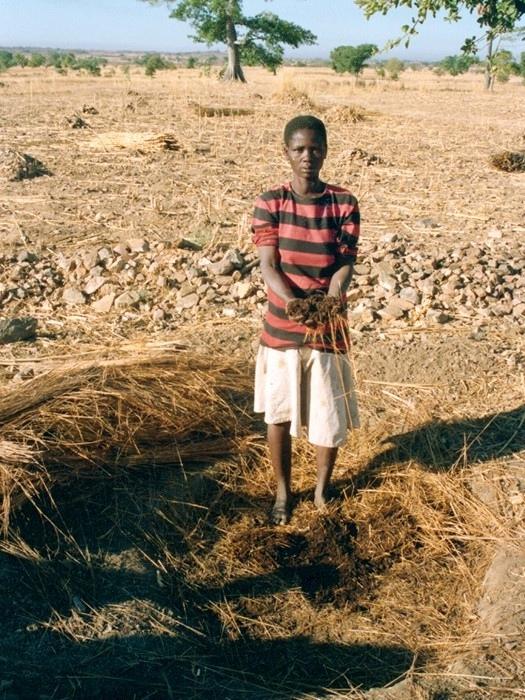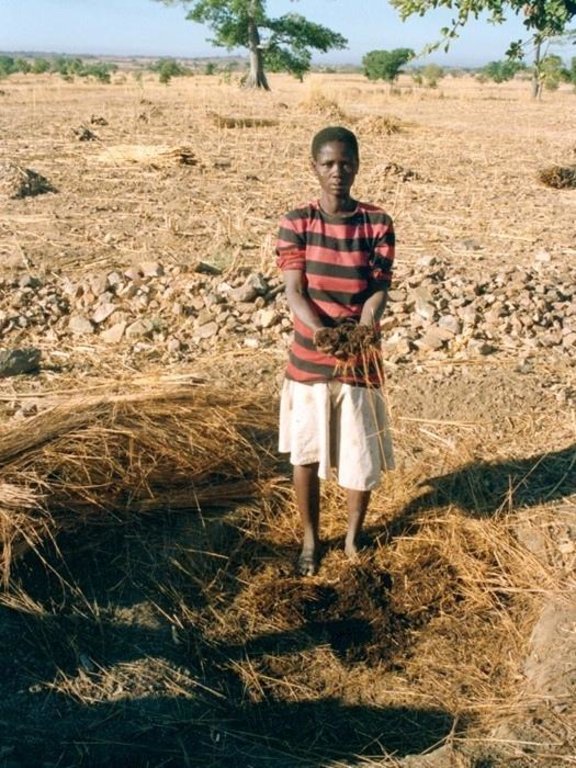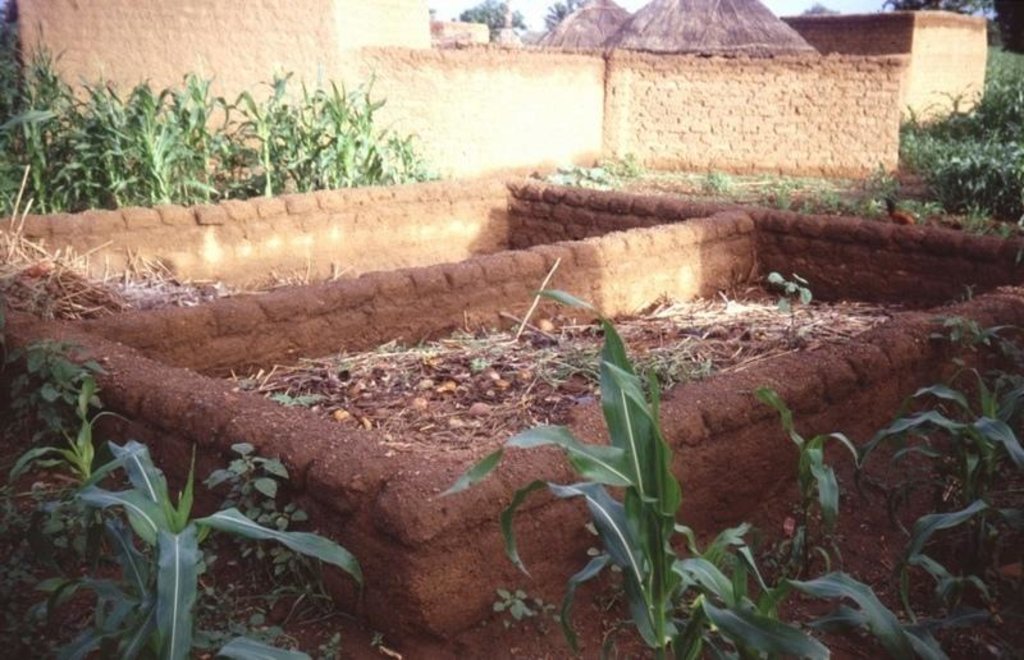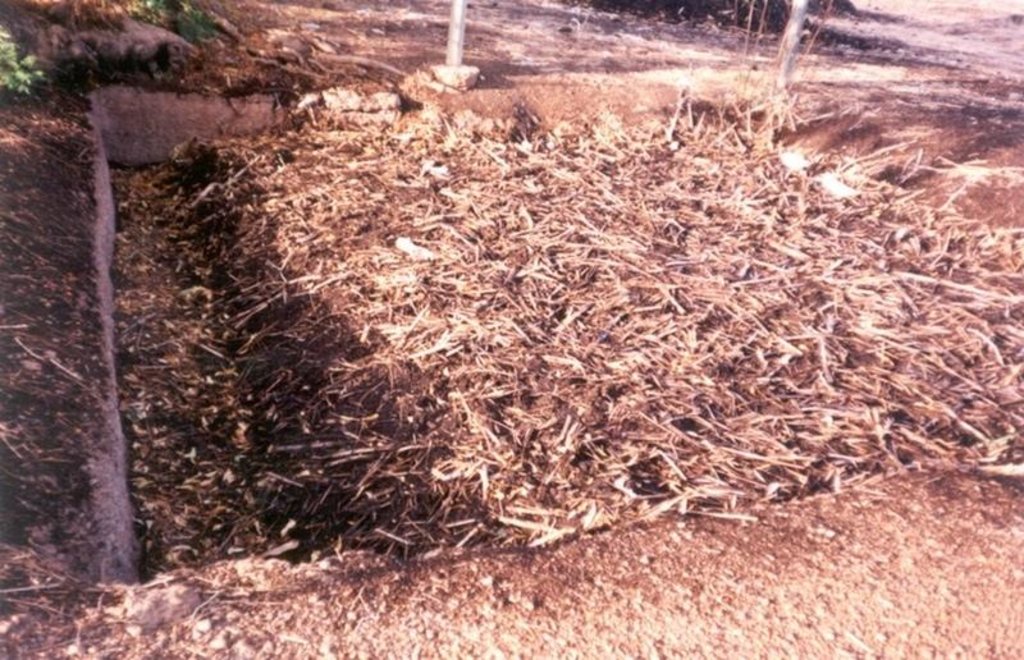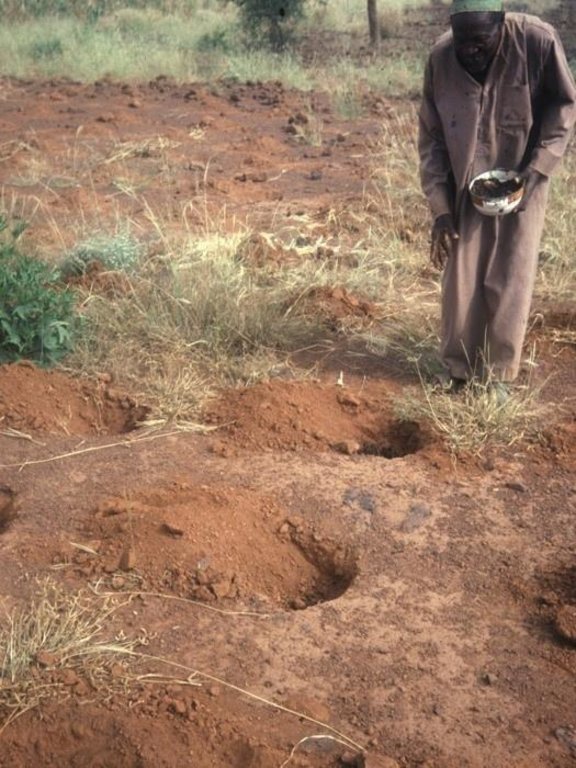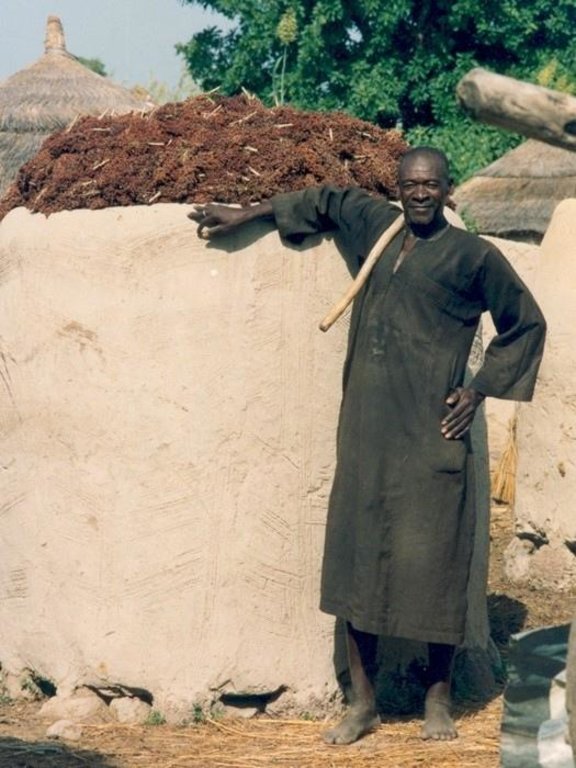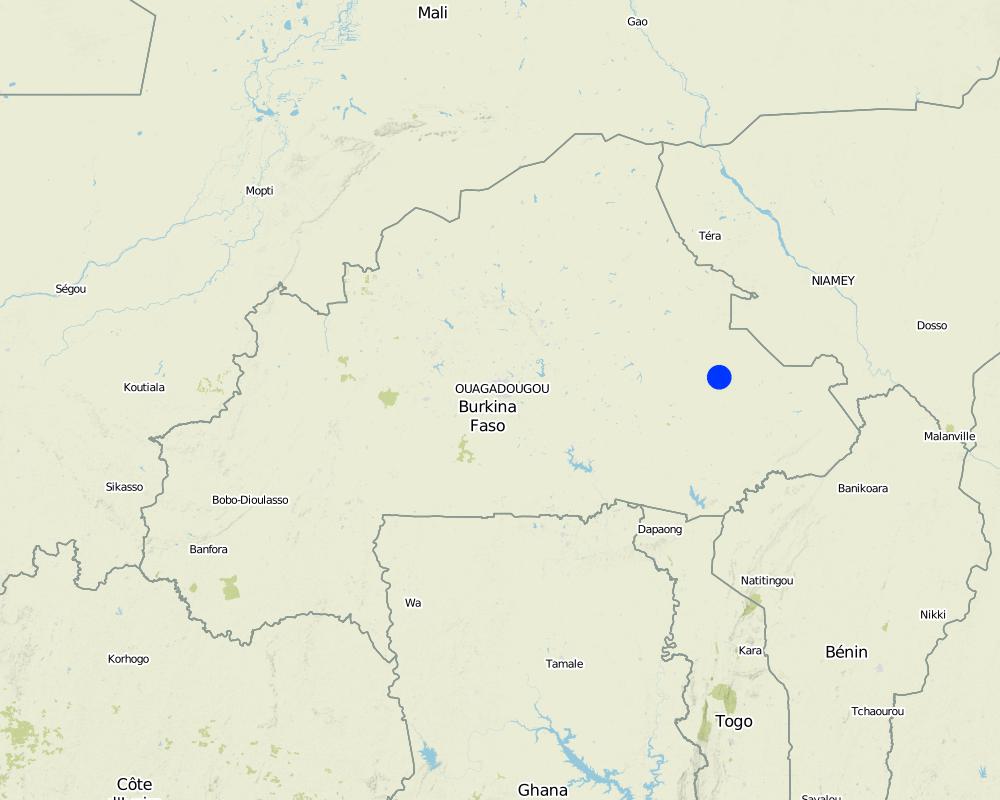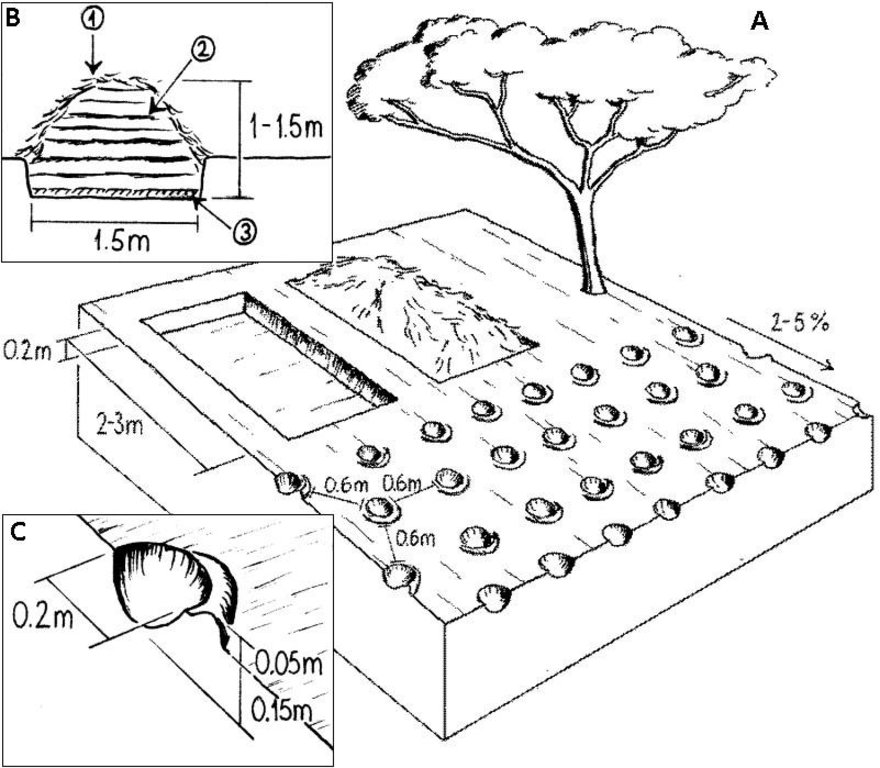Composting associated with planting pits [ប្រទេសបួគីណាហ្វាសូ]
- ការបង្កើត៖
- បច្ចុប្បន្នភាព
- អ្នកចងក្រង៖ Moussa Bonzi
- អ្នកកែសម្រួល៖ –
- អ្នកត្រួតពិនិត្យច្រើនទៀត៖ Fabian Ottiger, Alexandra Gavilano
Zai avec apport de compost (french)
technologies_959 - ប្រទេសបួគីណាហ្វាសូ
ពិនិត្យមើលគ្រប់ផ្នែក
ពង្រីកមើលទាំងអស់ បង្រួមទាំងអស់1. ព័ត៌មានទូទៅ
1.2 ព័ត៌មានលម្អិតពីបុគ្គលសំខាន់ៗ និងស្ថាប័នដែលចូលរួមក្នុងការវាយតម្លៃ និងចងក្រងឯកសារនៃបច្ចេកទេស
បុគ្គលសំខាន់ម្នាក់ (ច្រើននាក់)
អ្នកជំនាញឯកទេស SLM:
De Pury Jean Pascal Etienne
Centre Ecologique Albert Schweitzer (CEAS)
ប្រទេសស្វ៊ីស
អ្នកជំនាញឯកទេស SLM:
Ouedraogo Elisée
Centre Ecologique Albert Schweitzer (CEAS)
ប្រទេសស្វ៊ីស
អ្នកជំនាញឯកទេស SLM:
ឈ្មោះគម្រោងដែលបានចងក្រងឯកសារ/ វាយតម្លៃលើបច្ចេកទេស (បើទាក់ទង)
Book project: where the land is greener - Case Studies and Analysis of Soil and Water Conservation Initiatives Worldwide (where the land is greener)ឈ្មោះគម្រោងដែលបានចងក្រងឯកសារ/ វាយតម្លៃលើបច្ចេកទេស (បើទាក់ទង)
Book project: SLM in Practice - Guidelines and Best Practices for Sub-Saharan Africa (SLM in Practice)ឈ្មោះអង្គភាពមួយ (ច្រើន) ដែលបានចងក្រងឯកសារ/ វាយតម្លៃបច្ចេកទេស (បើទាក់ទង)
Centre Ecologique Albert Schweitzer (CEAS) - ប្រទេសស្វ៊ីសឈ្មោះអង្គភាពមួយ (ច្រើន) ដែលបានចងក្រងឯកសារ/ វាយតម្លៃបច្ចេកទេស (បើទាក់ទង)
INERA Institut de l'environnement et de recherches agricoles (INERA Institut de l'environnement et de recherches agricoles) - ប្រទេសបួគីណាហ្វាសូ1.3 លក្ខខណ្ឌទាក់ទងទៅនឹងការប្រើប្រាស់ទិន្នន័យដែលបានចងក្រងតាមរយៈ វ៉ូខេត
អ្នកចងក្រង និង(បុគ្គលសំខាន់ៗ)យល់ព្រមទទួលយកនូវលក្ខខណ្ឌនានាទាក់ទងទៅនឹងការប្រើប្រាស់ទិន្នន័យដែលបានចងក្រងតាមរយៈវ៉ូខេត:
បាទ/ចា៎
1.5 ការយោងទៅលើកម្រងបញ្ជីសំណួរ (មួយ ឬច្រើន) នៃវិធីសាស្ត្រផ្សព្វផ្សាយ SLM (ដែលបានចងក្រងដោយទស្សនៈពិភពលោកស្តីពីវិធីសាស្ត្រ និងបច្ចេកទេសងអភិរក្ស WOCAT)
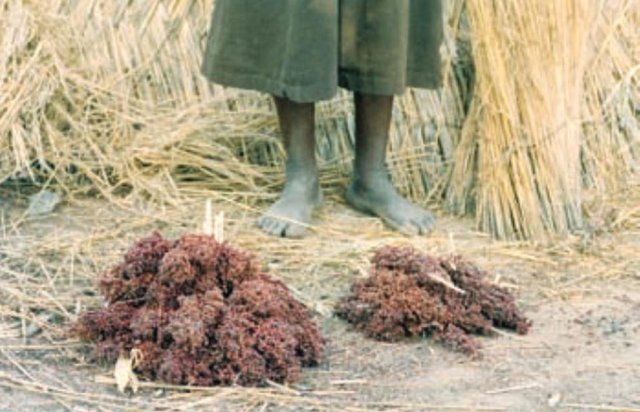
Zabré women’s agroecological programme [ប្រទេសបួគីណាហ្វាសូ]
A demand-driven initiative, by a women’s association, aimed at the promotion of composting through training and extension, using project staff and local facilitators.
- អ្នកចងក្រង៖ Unknown User
2. ការពណ៌នាពីបច្ចេកទេស SLM
2.1 ការពណ៌នាដោយសង្ខេបពីបច្ចេកទេស
និយមន័យបច្ចេកទេស:
Compost production, and its application in planting pits (zai) by farmers on fields near their homes.
2.2 ការពណ៌នាលម្អិតពីបច្ចេកទេស
ការពណ៌នា:
Compost is produced in shallow pits, approximately 20 cm deep and 1.5 m by 3 m wide. During November and December layers of chopped crop residues, animal dung and ash are heaped, as they become available, up to 1.5 m high and watered. The pile is covered with straw and left to heat up and decompose. After around 15-20 days the compost is turned over into a second pile and watered again. This is repeated up to three times - as long as water is available. Compost heaps are usually located close to the homestead. Alternatively, compost can be produced in pits which are up to one metre deep. Organic material is filled to ground level. The pit captures rain water, which makes this method of composting
a valuable option in dry areas.
The compost is either applied immediately to irrigated gardens, or kept in a dry shaded place for the next sorghum seeding. In the latter case one handful of compost is mixed with loose soil in each planting pit (zai). These pits are dug 60 cm by 60 cm apart. Three to four grains of sorghum are planted in each pit. Compost in the pits both conserves water and supplies nutrients. This enables the sorghum plants to establish better, grow faster and reach maturity before the rains finish. As compost is applied locally to the crop, not only is the positive effect maximised, but also the weeds between the pits do not benefit. The water retaining capacity of the compost (absorbing several times its own weight) makes the difference. This is much more important than the additional nutrients, which only become available in subsequent years, and do not anyway completely replace all the nutrients extracted by the crops.
The planting pits also help by harvesting runoff water from the microcatchments between them. Boulgou experiences erratic and variable rainfall with frequent droughts. The poor soils are often crusted and have a low water-retention capacity. Due to a high and increasing population, the land has become exhausted, and fallow periods are no longer sufficient as a consequence. Fertility and yields have declined. Sorghum without compost is more vulnerable to drought and crop failure.
During the dry season, after harvest, fields are grazed by cattle of the nomadic pastoral Peuhl, who also herd the agriculturalists’ livestock. Interestingly, the Peuhl have started to systematically collect the manure for sale, since the increased demand (for composting) has led to doubling of the price. Composting has been applied in Boulgou Province of Burkina Faso since 1988.
2.3 រូបភាពនៃបច្ចេកទេស
2.5 ប្រទេស/តំបន់/ទីតាំងកន្លែង ដែលបច្ចេកទេសត្រូវបានអនុវត្ត និងបានគ្រប់ដណ្តប់ដោយការវាយតម្លៃនេះ
ប្រទេស:
ប្រទេសបួគីណាហ្វាសូ
តំបន់/រដ្ឋ/ខេត្ត:
Boulgou Province, Burkina Faso
មតិយោបល់:
Total area covered by the SLM Technology is 200 km2.
Map
×2.7 ការណែនាំពីបច្ចេកទេស
សូមបញ្ជាក់តើបច្ចេកទេសត្រូវបានណែនាំឱ្យអនុវត្តដោយរបៀបណា:
- តាមរយៈគម្រោង / អន្តរាគមន៍ពីខាងក្រៅ
3. ចំណាត់ថ្នាក់នៃបច្ចេកទេស SLM
3.1 គោលបំណងចម្បង (១ ឬច្រើន) នៃបច្ចេកទេសនេះ
- ធ្វើឱ្យប្រសើរឡើងនូវផលិតកម្ម
- បង្កើតផលប្រយោជន៍សេដ្ឋកិច្ច
3.2 ប្រភេទដីប្រើប្រាស់មួយប្រភេទ (ច្រើនប្រភេទ) ដែលបានអនុវត្តបច្ចេកទេស
ដីប្រើប្រាស់ចម្រុះនៅលើដីតែមួយ:
បាទ/ចា៎
បញ្ជាក់ពីប្រភេទដីច្រើនប្រភេទ (ដីដាំដំណាំ/ដីចិញ្ចឹមសត្វ/ដីព្រៃឈើ):
- ដាំដំណាំ ចិញ្ចឹមសត្វ និងឈើ

ដីដាំដំណាំ
- ដំណាំប្រចាំឆ្នាំ
ដំណាំប្រចាំឆ្នាំ - បញ្ជាក់ប្រភេទដំណាំ:
- ដំណាំដែលមានគ្រាប់ចម្រាញ់ប្រេងបាន - សណ្តែកដី
- ធញ្ញជាតិ - ពោត
- ធញ្ញជាតិ - ពោតសាលី
- បន្លែ - បន្លែយកស្លឹក (សាលាដ ស្ពៃក្តោប ផ្ទី ផ្សេងៗ)
- បន្លែ - បន្លែយកមើម (ការ៉ុត ខ្ទឹមបារាំង ឆៃថាវម្យ៉ាង ផ្សេងៗ)
- ពពួកសណ្តែក - គ្រាប់ហោឡាំងតាវ
សូមបញ្ជាក់:
Longest growing period in days: 180 Longest growing period from month to month: May - Oct
តើជាការអនុវត្តន៍ដំណាំវិលជុំ?
បាទ/ចា៎

ដីសម្រាប់ចិញ្ចឹមសត្វ
ប្រភេទសត្វ:
- សត្វពពែ
- សត្វលា
- zebu cattle

ដីព្រៃ/ដីដាំដើមឈើ
ផលិតផល និងសេវាកម្ម:
- អុស
- ផ្លែឈើ និងគ្រាប់ធញ្ញជាតិ
មតិយោបល់:
Major land use problems (compiler’s opinion): Population increase has led to cultivation of all the available arable land, thus shortening or eliminating fallow periods.
Organic matter in the soil is reduced, the water holding capacity of the soil has diminished and consequently yields have fallen. This has been compounded by the droughts of the 1970s and 1980s. Thirty years ago farmers harvested 800 kg/ha each year, but by the 1980s yields had fallen to merely 400 kg/ha on average.
Main products/ services: Sorghum and zebu cattle (after harvest)
3.4 ការផ្គត់ផ្គង់ទឹក
ការផ្គត់ផ្គង់ទឹកនៅកន្លែងអនុវត្តបច្ចេកទេស:
- ទឹកភ្លៀង
3.5 ក្រុម SLM ដែលបច្ចេកទេសស្ថិតនៅក្នុង
- ធ្វើឱ្យប្រសើរឡើងគម្របដី/ ដំណាំគម្របដី
- ការគ្រប់គ្រងជីជាតិដីតាមបែបចម្រុះ
- ការស្តុកទុកទឹក
3.6 វិធានការ SLM ដែលបញ្ចូលនូវបច្ចេកទេស

វិធានការក្សេត្រសាស្ត្រ
3.7 កំណត់ប្រភេទនៃការធ្លាក់ចុះគុណភាពដីសំខាន់ៗដែលបច្ចេកទេសនេះបានដោះស្រាយ

ការហូរច្រោះដីដោយសារទឹក
- Wt: ការបាត់ដីស្រទាប់លើដោយការហូរច្រោះ

ការធ្លាក់ចុះសារធាតុគីមីក្នុងដី
- Cn: ការថយចុះជីជាតិ និងកាត់បន្ថយបរិមាណសារធាតុសរីរាង្គ (មិនកើតឡើងដោយការហូរច្រោះទេ)

ការបាត់បង់រូបសាស្ត្រនៃដី
- Pc: ការហាប់ណែន
- Pk: ការបិទរន្ធដី

ការបាត់បង់ទឹក
- Ha: ការថយចុះសំណើមដី
មតិយោបល់:
Main type of degradation addressed: Wt: loss of topsoil / surface erosion, Cn: fertility decline and reduced organic matter content, Pc: compaction, Pk: sealing and crusting, Ha: aridification
Main causes of degradation: over-exploitation of vegetation for domestic use, other human induced causes (specify) (causes agricoles: Suppression des jachères; surpâturage), other natural causes (avalanches, volcanic eruptions, mud flows, highly susceptible natural resources, extreme topography, etc.) specify (Secheresse du sol due à la destruction de l'humus plus qu'aumanque de pluie.), Expansion démographique, manque de connaissances (Comment acquerir ces connaissances)
Secondary causes of degradation: deforestation / removal of natural vegetation (incl. forest fires), manque de moyens financiers (comment en produire avec des connaissances)
3.8 ការពារ កាត់បន្ថយ ឬស្តារឡើងវិញនៃការធ្លាក់ចុះគុណភាពដី
បញ្ជាក់ពីគោលដៅរបស់បច្ចេកទេស ដែលផ្តោតទៅការធ្លាក់ចុះគុណភាពដី:
- ការកាត់បន្ថយការធ្លាក់ចុះគុណភាពដី
4. បច្ចេកទេសជាក់លាក់ សកម្មភាពអនុវត្ត ធាតុចូល និងថ្លៃដើម
4.1 គំនូសបច្ចេកទេសនៃបច្ចេកទេសនេះ
លក្ខណៈពិសេសនៃបច្ចេកទេស (ទាក់ទងនឺងគំនូរបច្ចេកទេស):
A: Overview of compost making and zai planting pits within a field. Tree shade helps to conserve moisture in the compost pits.
B: Cross section of compost pit: protective straw (1); successive layers of compost (2), clay layer at the bottom (3).
C: Detailed view of zai planting pit.
Technical knowledge required for field staff / advisors: low
Technical knowledge required for land users: moderate
Main technical functions: increase / maintain water stored in soil
Secondary technical functions: increase in organic matter, increase of infiltration, increase in soil fertility, improvement of soil structure
Manure / compost / residues
Material/ species: compost
Quantity/ density: 7-10 t/ha
Remarks: applied in planting pits
ឈ្មោះអ្នកនិពន្ធ:
Mats Gurtner
4.3 សកម្មភាពបង្កើត
| សកម្មភាព | រយៈពេល (រដូវកាល) | |
|---|---|---|
| 1. | Transport compost to the fields: | April / annual |
| 2. | Deepen planting pits (zai) (to original dimensions of 15 cm deep, 20 cm diameter, and 60 cm apart) and apply a handful of compost mixed with earth, just before planting sorghum | After the first rains / annual |
មតិយោបល់:
Editors’ comments: Soil fertility decline is a major problem for much of Africa, and composting provides an opportunity for local mitigation of this. There are many ways of making compost, and this case is a good example of ‘aerobic heap compost’ from Burkina Faso. Here, the compost is concentrated in planting pits, which additionally harvest water.
4.4 ថ្លៃដើម និងធាតុចូលដែលត្រូវការសម្រាប់ការបង្កើតបច្ចេកទេស
| បញ្ជាក់ពីធាតុចូល | ឯកតា | បរិមាណ | ថ្លៃដើមក្នុងមួយឯកតា | ថ្លៃធាតុចូលសរុប | % នៃថ្លៃដើមដែលចំណាយដោយអ្នកប្រើប្រាស់ដី | |
|---|---|---|---|---|---|---|
| កម្លាំងពលកម្ម | Labour | ha | 1,0 | 2,0 | 2,0 | 100,0 |
| សម្ភារៈ | Tools | ha | 1,0 | 10,0 | 10,0 | 100,0 |
| សម្ភារៈសាងសង់ | Clay | 1 | ||||
| ថ្លៃដើមសរុបក្នុងការបង្កើតបច្ចេកទេស | 12,0 | |||||
| ថ្លៃដើមសរុបក្នុងការបង្កើតបច្ចេកទេសគិតជាដុល្លារ | 12,0 | |||||
4.5 សកម្មភាពថែទាំ
| សកម្មភាព | ពេលវេលា/ ភាពញឹកញាប់ | |
|---|---|---|
| 1. | Dig two compost pits (3 m by 1.5 m and 20 cm deep). Cover the bottom of each pit with 3 cm clay layer. | beginning of the dry season (November). / initial establishment |
| 2. | Put 20 cm layer of chopped crop residues (cereal straw) into thecompost pit (water with one bucket). Add 5 cm layer of animal manure. Add 1 cm layer of ash. Repeat steps 1–3 until the compost pile is 1.0–1.5 m high. | November / annual |
| 3. | Cover pile with straw to reduce evaporation, and leave to decompose. | November / annual / up to 3 times (as long as water is available) |
| 4. | Turn compost after 15 days into the 2nd pit, then after another 15 days back into the 1st pit. Water the pile after each turning with 3 buckets of water. | / up to 3 times (as long as water is available) |
| 5. | Store ready compost in dry shady place. | January / annual |
4.6 កំណត់ថ្លៃដើមសម្រាប់ការថែទាំ/ សកម្មភាពរបស់បច្ចេកទេស (ក្នុងរយៈពេលមួយឆ្នាំ)
| បញ្ជាក់ពីធាតុចូល | ឯកតា | បរិមាណ | ថ្លៃដើមក្នុងមួយឯកតា | ថ្លៃធាតុចូលសរុប | % នៃថ្លៃដើមដែលចំណាយដោយអ្នកប្រើប្រាស់ដី | |
|---|---|---|---|---|---|---|
| កម្លាំងពលកម្ម | Labour | ha | 1,0 | 20,0 | 20,0 | 100,0 |
| សម្ភារៈ | Wheelbarrow renting | ha | 1,0 | 6,0 | 6,0 | 100,0 |
| សម្ភារៈ | None | None | 1,0 | |||
| សម្ភារៈ | None | None | 1,0 | |||
| ជី និងសារធាតុពុល | Compost/manure | ha | 1,0 | 2,0 | 2,0 | 100,0 |
| សម្ភារៈសាងសង់ | Wet straw | ha | ||||
| សម្ភារៈសាងសង់ | ash | ha | ||||
| ផ្សេងៗ | Compost transportation | ha | 1,0 | 2,0 | 2,0 | 100,0 |
| ថ្លៃដើមសរុបសម្រាប់ការថែទាំដំណាំតាមបច្ចេកទេស | 30,0 | |||||
| ថ្លៃដើមសរុបសម្រាប់ការថែទាំដំណាំតាមបច្ចេកទេសគិតជាដុល្លារ | 30,0 | |||||
មតិយោបល់:
Machinery/ tools: hoe, knife, digging stick, bucket
Costs relate to production and application of one ton of compost per hectare - which a farmer can make in one year and is the product of one full compost pit. The compost is directly applied to each planting pit: since the pits all in all
constitute only around 10-15% of the field surface, compost is effectively applied at a concentration of 7-10 t/ha. This rate is equal to actual rates applied in small irrigated gardens (<0.1 ha). If compost is produced in deep pits, production is cheaper because there is less work involved.
4.7 កត្តាសំខាន់បំផុតដែលមានឥទ្ធិពលដល់ការចំណាយ
ពណ៌នាពីកត្តាប៉ះពាល់ចម្បងៗទៅលើថ្លៃដើម:
Duration of establishment: 1 week
5. លក្ខណៈបរិស្ថានធម្មជាតិ និងមនុស្ស
5.1 អាកាសធាតុ
បរិមាណទឹកភ្លៀងប្រចាំឆ្នាំ
- < 250 មម
- 251-500 មម
- 501-750 មម
- 751-1,000 មម
- 1,001-1,500 មម
- 1,501-2,000 មម
- 2,001-3,000 មម
- 3,001-4,000 មម
- > 4,000 មម
តំបន់កសិអាកាសធាតុ
- មានភ្លៀងតិចតួច
Thermal climate class: tropics
5.2 សណ្ឋានដី
ជម្រាលជាមធ្យម:
- រាបស្មើ (0-2%)
- ជម្រាលតិចតួច (3-5%)
- មធ្យម (6-10%)
- ជម្រាលខ្ពស់បន្តិច (11-15%)
- ទីទួល (16-30%)
- ទីទួលចោត (31-60%)
- ទីទួលចោតខ្លាំង (>60%)
ទម្រង់ដី:
- ខ្ពង់រាប
- កំពូលភ្នំ
- ជម្រាលភ្នំ
- ជម្រាលទួល
- ជម្រាលជើងភ្នំ
- បាតជ្រលងភ្នំ
តំបន់តាមរយៈកម្ពស់ :
- 0-100 ម
- 101-500 ម
- 501-1,000 ម
- 1,001-1,500 ម
- 1,501-2,000 ម
- 2,001-2,500 ម
- 2,501-3,000 ម
- 3,001-4,000 ម
- > 4,000 ម
5.3 ដី
ជម្រៅដីជាមធ្យម:
- រាក់ខ្លាំង (0-20 សម)
- រាក់ (21-50 សម)
- មធ្យម (51-80 សម)
- ជ្រៅ (81-120 សម)
- ជ្រៅខ្លាំង (> 120 សម)
វាយនភាពដី (ស្រទាប់លើ):
- គ្រើម/ មានពន្លឺ (ខ្សាច់)
- ម៉ត់/ ធ្ងន់ (ឥដ្ឋ)
សារធាតុសរីរាង្គនៅស្រទាប់ដីខាងលើ:
- ទាប (<1%)
បើអាចសូមភ្ជាប់ការពណ៌នាពីដីឱ្យបានច្បាស់ ឬព័ត៌មានដែលអាចទទួលបាន ឧ. ប្រភេទដី, pH ដី/ ជាតិអាស៊ីត, សមត្ថភាពផ្លាស់ប្តូរកាចុង, វត្តមាននីត្រូសែន, ភាពប្រៃ ។ល។:
Soil texture: Fine / heavy (elevations) and coarse/light (depressions)
Soil fertility: Low (ranked 1) and medium (ranked 2)
Topsoil organic matter: Low (and decreasing further)
Soil drainage/infiltration: Poor (ranked 1) and medium (ranked 2)
Soil water storage capacity: Low
5.6 លក្ខណៈនៃអ្នកប្រើប្រាស់ដីដែលអនុវត្តបច្ចេកទេស
ទីផ្សារនៃប្រព័ន្ធផលិតកម្ម:
- សម្រាប់ហូបក្នុងគ្រួសារ (ផ្គត់ផ្គង់ខ្លួនឯង)
- ពាក់កណ្តាលពាណិជ្ជកម្ម (ផ្គត់ផ្គង់ខ្លួនឯង/ ពាណិជ្ជកម្ម)
ចំណូលក្រៅកសិកម្ម:
- តិចជាង 10% នៃចំណូល
កម្រិតប្រើប្រាស់គ្រឿងយន្ត:
- ប្រើកម្លាំងពលកម្ម
- ប្រើកម្លាំងសត្វ
សូមបញ្ជាក់ពីលក្ខណៈពាក់ព័ន្ធផ្សេងទៀតអំពីអ្នកប្រើប្រាស់ដី:
Market orientation: Subsistence (ranked 1) and mixed (ranked 2, in good years)
5.7 ទំហំផ្ទៃដីជាមធ្យមនៃដីប្រើប្រាស់ដោយអ្នកប្រើប្រាស់ដី ក្នុងការអនុវត្តបច្ចេកទេស
- < 0.5 ហិកតា
- 0.5-1 ហិកតា
- 1-2 ហិកតា
- 2-5 ហិកតា
- 5-15 ហិកតា
- 15-50 ហិកតា
- 50-100 ហិកតា
- 100-500 ហិកតា
- 500-1,000 ហិកតា
- 1,000-10,000 ហិកតា
- > 10,000 ហិកតា
មតិយោបល់:
Average area of land owned or leased by land users applying the Technology: 0.5-1 ha, 1-2 ha, 2-5 ha
5.8 ភាពជាម្ចាស់ដី កម្មសិទ្ធប្រើប្រាស់ដី និងកម្មសិទ្ធប្រើប្រាស់ទឹក
ភាពជាម្ចាស់ដី:
- ភូមិ
កម្មសិទ្ធិប្រើប្រាស់ដី:
- ជាក្រុម (មានដែនកំណត់)
6. ផលប៉ះពាល់ និងការសន្និដ្ឋាន
6.1 ផលប៉ះពាល់ក្នុងបរិវេណអនុវត្តបច្ចេកទេសដែលកើតមាន
ផលប៉ះពាល់លើសេដ្ឋកិច្ចសង្គម
ផលិតផល
ផលិតកម្មដំណាំ
ផលិតកម្មចំណីសត្វ
គុណភាពចំណីសត្វ
ចំណូល និងថ្លៃដើម
ចំណូលក្នុងកសិដ្ឋាន
មតិយោបល់/ ការបញ្ជាក់:
By several times in dry years, compared to no compost use
បន្ទុកការងារ
ផលប៉ះពាល់ទៅលើសេដ្ឋកិច្ចសង្គមផ្សេងៗ
Integration of agriculturalists and pastoralists
Input constraints
មតិយោបល់/ ការបញ្ជាក់:
Water for compost making
ផលប៉ះពាល់ទៅលើវប្បធម៌សង្គម
ស្ថាប័នសហគមន៍
ការកាត់បន្ថយជម្លោះ
ផលប៉ះពាល់ទៅលើអេកូឡូស៊ី
វដ្តទឹក/លំហូរ
ប្រព័ន្ធបង្ហូរទឹក
ដី
សំណើមដី
គម្របដី
ការបាត់បង់ដី
ផលប៉ះពាល់ទៅលើអេកូឡូស៊ីផ្សេងៗ
Soil fertility
6.4 ការវិភាគថ្លៃដើម និងអត្ថប្រយោជន៍
តើផលចំណេញ និងថ្លៃដើមត្រូវបានប្រៀបធៀបគ្នាយ៉ាងដូចម្តេច (ទស្សនៈរបស់អ្នកប្រើប្រាស់ដី)?
រយៈពេលខ្លី:
វិជ្ជមានខ្លាំង
រយៈពេលវែង:
វិជ្ជមានខ្លាំង
តើផលចំណេញ និងការថែទាំ/ ជួសជុលត្រូវបានប្រៀបធៀបគ្នាយ៉ាងដូចម្តេច (ទស្សនៈរបស់អ្នកប្រើប្រាស់ដី)?
រយៈពេលខ្លី:
វិជ្ជមានខ្លាំង
រយៈពេលវែង:
វិជ្ជមានខ្លាំង
6.5 ការទទួលយកបច្ចេកទេស
បើអាច សូមបញ្ជាក់ពីបរិមាណ (ចំនួនគ្រួសារ និង/ ឬតំបន់គ្របដណ្តប់):
5000
ក្នុងចំណោមគ្រួសារទាំងអស់ដែលបានអនុវត្តបច្ចេកទេស តើមានប៉ុន្មានគ្រួសារដែលចង់ធ្វើដោយខ្លួនឯង ដោយមិនទទួលបានសម្ភារៈលើកទឹកចិត្ត/ប្រាក់ឧបត្ថម្ភ?:
- 91-100%
មតិយោបល់:
100% of land user families have adopted the Technology without any external material support
There is a strong trend towards spontaneous adoption of the Technology
Comments on adoption trend: Strong trend towards growing spontaneous adoption. Almost everybody wants to imitate neighbors - but not everyone had received adequate training. Demand grew because of the expanded membership of the association. Some pastoralists use it in their gardens.
6.7 ភាពខ្លាំង/ គុណសម្បត្តិ/ ឱកាសនៃបច្ចេកទេស
| ភាពខ្លាំង/ គុណសម្បត្តិ/ ឱកាស ទស្សនៈរបស់បុគ្គលសំខាន់ៗ |
|---|
|
All land users, even the poorest, can learn to make and apply compost. No jealousy amongst land users, which is a prerequisite for ist spread/acceptance How can they be sustained / enhanced? Keep going with training and extension. |
|
Possibility of doubling cereal yields in normal years: any surplus production can be sold How can they be sustained / enhanced? Produce enough good compost/manure. |
| Ensures yields in dry years, giving security against drought and hunger. |
|
Gives high income in dry years due to production increase and double prices on the market for the surplus How can they be sustained / enhanced? However the government is attempting to stabilise prices, so this benefit might not endure. |
| Requires only locally available resources, and knowledge about compost application is ‘owned’ by the farmers: nobody can take it away from them. |
6.8 ភាពខ្សោយ/ គុណវិបត្តិ/ ហានិភ័យនៃបច្ចេកទេស និងវិធីសាស្ត្រដោះស្រាយ
| ភាពខ្សោយ/ គុណវិបត្តិ/ ហានិភ័យ ទស្សនៈរបស់អ្នកចងក្រងឬបុគ្គលសំខាន់ៗ | តើបច្ចេកទេសទាំងនោះបានដោះស្រាយបញ្ហាដូចម្តេច? |
|---|---|
| The modest quantity of compost applied is not enough to replace the nutrients extracted by the crops in the long term | Small amounts of nitrogen and phosphorous fertiliser need to be added and crop rotation practiced. |
| The short/medium term local benefits are not associated with a positive overall, long-term ecological impact because there is a net transfer of organic matter (manure) to the fields from the surroundings | Improve management of the vegetation outside the cropland, avoiding overgrazing etc to increase manure production. |
| Needs considerable water and thus also extra labour | Pit composting helps to reduce water requirement in drier areas and at the same time reduces labour input. |
7. ឯកសារយោង និងវេបសាយ
7.1 វិធីសាស្ត្រ/ ប្រភពនៃព័ត៌មាន
7.2 ឯកសារយោងដែលបានចេញផ្សាយ
ចំណងជើង អ្នកនិពន្ធ ឆ្នាំ ISBN:
Ouedraogo E . Influence d’un amendement de compost sur sol ferrugineux tropicaux en milieu paysan. Impact sur laproduction de sorgho à Zabré en 1992. Mémoire de diplôme.. 1992.
មានប្រភពមកពីណា? ថ្លៃដើមប៉ុន្មាន?
CEAS Neuchâtel, Switzerland
ចំណងជើង អ្នកនិពន្ធ ឆ្នាំ ISBN:
Zougmore R, Bonzi M, et Zida Z . Etalonnagedes unités locales de mesures pour le compostage en fosse de type unique étanche durable. Fiche technique de quantification des matériaux decompostage, 4pp. 2000.
ចំណងជើង អ្នកនិពន្ធ ឆ្នាំ ISBN:
Zougmore R, Bonzi M, et Zida Z . Etalonnagedes unités locales de mesures pour le compostage en fosse de type unique étanche durable. Fiche technique de quantification des matériaux decompostage, 4pp. 2000.
ចំណងជើង អ្នកនិពន្ធ ឆ្នាំ ISBN:
Zougmore R, Bonzi M, et Zida Z . Etalonnagedes unités locales de mesures pour le compostage en fosse de type unique étanche durable. Fiche technique de quantification des matériaux decompostage, 4pp. 2000.
ចំណងជើង អ្នកនិពន្ធ ឆ្នាំ ISBN:
Zougmore R, Bonzi M, et Zida Z . Etalonnagedes unités locales de mesures pour le compostage en fosse de type unique étanche durable. Fiche technique de quantification des matériaux decompostage, 4pp. 2000.
ចំណងជើង អ្នកនិពន្ធ ឆ្នាំ ISBN:
Zougmore R, Bonzi M, et Zida Z . Etalonnagedes unités locales de mesures pour le compostage en fosse de type unique étanche durable. Fiche technique de quantification des matériaux decompostage, 4pp. 2000.
ការតភ្ជាប់ និងម៉ូឌុល
ពង្រីកមើលទាំងអស់ បង្រួមទាំងអស់ការតភ្ជាប់

Zabré women’s agroecological programme [ប្រទេសបួគីណាហ្វាសូ]
A demand-driven initiative, by a women’s association, aimed at the promotion of composting through training and extension, using project staff and local facilitators.
- អ្នកចងក្រង៖ Unknown User
ម៉ូឌុល
គ្មានម៉ូឌុល


